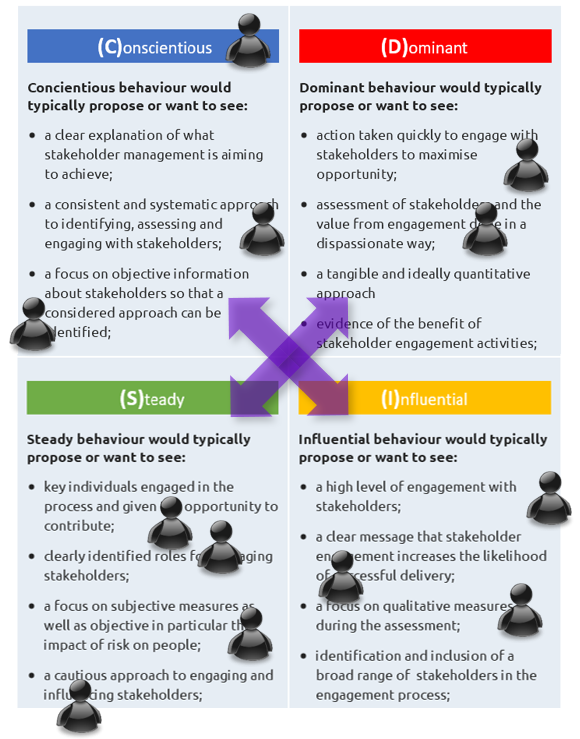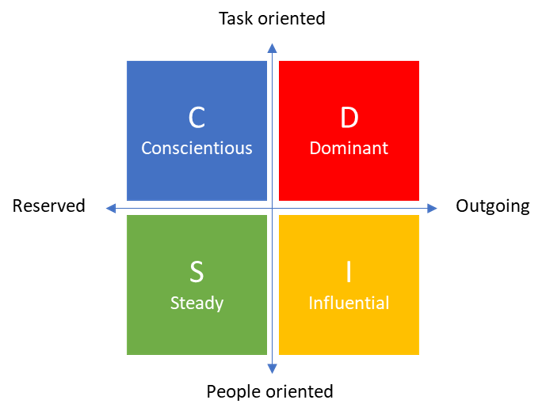Project, programme and portfolio management is a team game. People come together with different skills to fulfil different roles. They also come together with their own individual motivations, perspectives and preferences.
P3M methods and standards do not take these different personalities and their impact into account. They describe functions and processes from a single perspective but people view them from multiple perspectives, not necessarily understanding that others see things, and act, differently.
This section of the Praxis Framework aims to correct that omission. It has been developed by Praxis and Team Animation Ltd. and looks at the key functions and processes from the four perspectives described by the DISC model. The letters D, I, S and C, describe four primary character types Dominant, Influential, Steady and Conscientious. 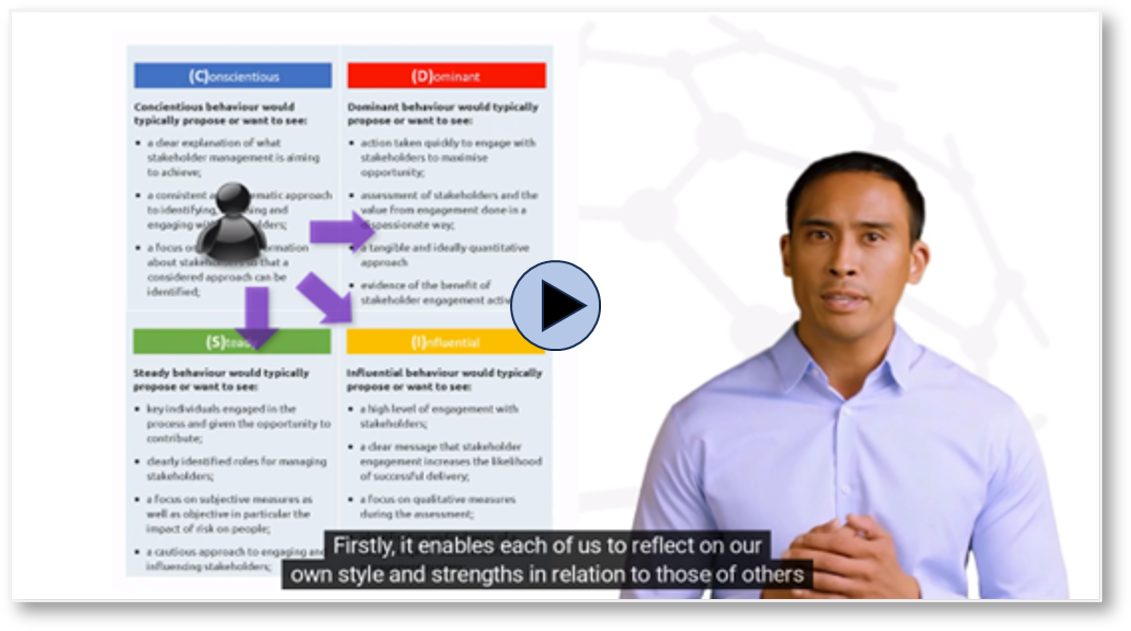
The purpose of the Team Praxis pages is to describe how the four primary personality types view aspects of P3M in different ways. This is really important if you wish to understand how the team can most effectively work together .
If each team member appreciates that others don’t perceive a document or a proposed way to solve an issue in the same way that they do, then there is the opportunity to resolve misunderstanding or conflict before it arises. The team can then benefit from the diversity of views and experiences of its members.
DISC is the basis of many psychometric models used in business today. Millions of people have taken a DISC based assessment. Some of the better-known ones are:
- Insights
- Everything DiSC® from Wiley
- iMA
- Discus
Each form of assessment presents the in different ways even though they have the same underlying basis. Most assign colours to the four types. The colours used for each type, and even sometimes the labels that D, I, S and C stand for can vary. The one thing they agree on are the letters D, I, S and C.
The Praxis approach uses the most common labels for the four types, the most common colours aligned with the four types and the most common arrangement of the four types in a 2x2 matrix.
- Dominant
-
D’s are likely to be vocal and direct in meetings. They will assert the points they wish to discuss and are independent minded. If they are the leader by seniority or title in the meeting, then they will seek to cover points as quickly as possible and wish decisions to be made without extended analysis or discussion.
-
D's are generally comfortable with conflict and can even thrive and may push harder than other more passive profiles to assert their will and take control of a meeting or situation. They may appear pushy and critical if conflict arises.
- Influential
-
I’s are lively contributors to meetings providing new Ideas and will look to keep an informal approach. If they are the leader by seniority or title in the meeting, then they will be enthusiastic leaders and be open to a broad range of topics being discussed and different opinions and options explored.
-
They are happy for the structure of the meetings to evolve and change as they see the value in another people’s input. I’s are generally comfortable with conflict and aware of the social dynamics of a situation and will look for alliances to be formed. They will seek to defuse conflict with humour and may appear opinionated and impulsive in such situations.
- Steady
-
S’s are reserved and supportive and may not actively contribute but will be sympathetic to others' perspectives, as well as excellent active listeners. If they are the leader by seniority or title, they will seek meetings to be consistent and people to have delivered what they had committed to.
-
S’s are generally uncomfortable with conflict, seeking out calm, steady environments and will help resolve conflict by being diplomatic and generally supportive. They may appear indecisive and withdrawn if conflict arises.
- Conscientious
-
C’s are reserved and reflective and therefore may not actively contribute to meetings until they believe they can add value or have a strong objection to a particular point. They prefer to work independently so would prefer individual rather than joint actions.
-
If they are the leader by seniority or title in the meeting, then they will have prepared for the meeting and expect others to have done the same, demand a structure that is followed and discussions focused on objective discussions. C ’s are generally uncomfortable with conflict and will use logic to resolve the situation. They may appear withdrawn and slow to act if conflict arises.
If you have already done a DISC based assessment, make a note of your dominant letter and look at the Team Praxis pages to see how your perspective on the functions and processes of P3M compare to other people. If other members of your team have also done DISC assessments, they should do the same thing and then collectively, you can begin to understand each other’s points of view and work out best to work as a team and gain value from the diversity of the team.
This table compares the colours used by some of the better-known assessments to help you translate between them and the Team Praxis format.
Product | D Dominant | I Influential | S Steady | C Conscientious |
|---|---|---|---|---|
Insights | Fiery Red | Sunshine Yellow | Earth Green | Cool Blue |
iMA | Hi Red | Hi Yellow | Hi Blue | Hi Green |
Wiley | Green | Red | Blue | Yellow |
Discus | Red | Yellow | Green | Blue |
Salesbox | Red | Yellow | Green | Blue |
Disc Personality Testing | Green | Red | Blue | Yellow |
If you haven’t previously done a DISC based assessment, there are a number of free versions. For a quick and binary approach use www.ima-pm.co.uk.
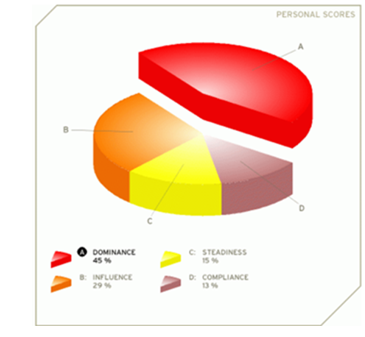 For a more nuanced view we would suggest the version at www.123test.com/disc-personality-test/index.php
For a more nuanced view we would suggest the version at www.123test.com/disc-personality-test/index.php
The first link will simply give you your primary type.
The second will give you a percentage for each of the four types. In this example, the person’s main personality trait is Dominance with Influence as their secondary trait.
You can use this to understand how your preferences in different P3M functions and processes relate to those of your team.
How to use Team Praxis
The insights from the Team Praxis pages can be used to improve the adoption and application of key P3M techniques in your current role or if you are looking to add a fresh perspective and capability to improve future performance. Firstly complete a DISC diagnostic and then reflect on your own style and how adapting it, given the context, may be advantageous to you personally and the project, programme or portfolio you work on.
The examples used below are for stakeholder management but the same principle applies to all the Team Praxis pages.
Please note that all descriptions are written as definitive statements to reduce the use of “in most situations or cases”, “primarily”, “has a preference for”, etc. It must therefore be noted that we are identifying a most frequent preference not an absolute characteristic.
- Reflecting on your own style and strengths
-
Identify what you would typically propose or want to see (e.g. a conscientious tyoe shown in the figure), consider if this is appropriate given the context; have a look at how other character types would tackle the same activity and think about how it would be best for you to interact with these other styles.
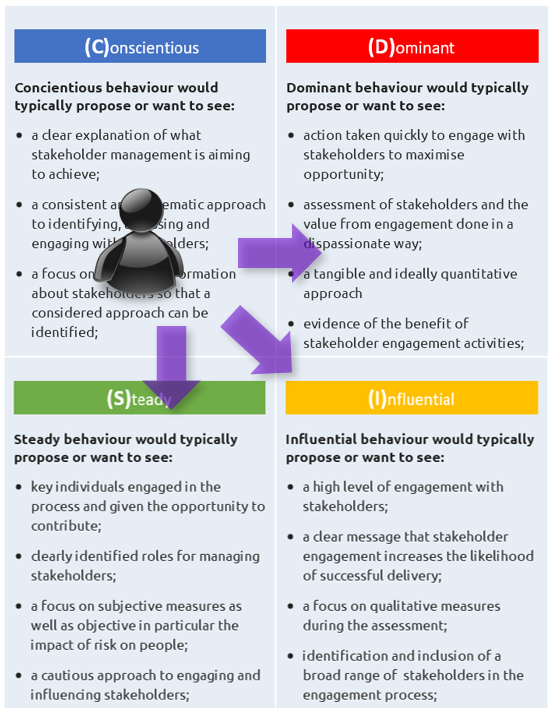
- Working with others – individuals or teams
-
Identify your colleagues' characteristics, consider the implications in terms of your interaction and how other characters will tackle the task or deal with the situation. How this will impact you and adapt your approach as appropriate. This approach can be used for entire teams by considering the collective profile of the team members.
